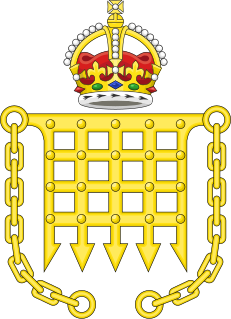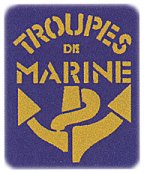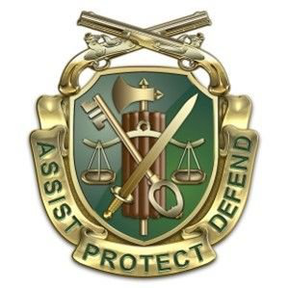Related Research Articles

The Sammarinese Armed Forces refers to the national military defence forces of the country of San Marino. It is one of the smallest military forces in the world, with its different branches having varied functions including: performing ceremonial duties; patrolling borders; mounting guard at government buildings; and assisting police in major criminal cases. There is also a military Gendarmerie which is part of the military forces of the republic. The entire military corps of San Marino depends upon the co-operation of full-time forces and their retained (volunteer) colleagues, known as the Corpi Militari Volontari, or Voluntary Military Force. National defence in the face of an aggressive world power is, by arrangement, the responsibility of Italy's armed forces. The component parts of the military are distinguished by distinctive cap badges, one each for the Fortress Guard (uniformed), Fortress Guard (artillery), Guard of the Council, Uniformed Militia, Military Ensemble (band), and Gendarmerie. There is no compulsory service, however under special circumstances citizens aged 16 to 55 may be drafted for the defence of the state.

A salute is a gesture or other action used to display respect. Salutes are primarily associated with armed forces, but other organizations and civilians also use salutes.

The Tomb of the Unknown Soldier or the Tomb of the Unknowns is a monument dedicated to deceased U.S. service members whose remains have not been identified. It is located in Arlington National Cemetery in Virginia, United States of America. The World War I "Unknown" is a recipient of the Medal of Honor, the Victoria Cross, and several other foreign nations' highest service awards. The U.S. Unknowns who were interred are also recipients of the Medal of Honor, presented by U.S. Presidents who presided over their funerals. The monument has no officially designated name.

The Sam Browne belt is a wide belt, usually leather, supported by a narrower strap passing diagonally over the right shoulder. It is most often a part of a military or police uniform.

A drill instructor is a non-commissioned officer in the armed forces or police forces with specific duties that vary by country. For example, in the United States armed forces, they are assigned the duty of training new recruits entering the military.

In military combat, cover is anything which is capable of physically protecting an individual from enemy fire. This differentiates it from the similar concept of concealment, in that an object or area of concealment only affords the benefit of stealth, not actual protection from small arms fire or artillery fragments. An example of "cover vs. concealment" would be sandbags vs. tall grass. Cover may be a naturally occurring feature, such as a rock or a tree stump, or it may be a constructed feature, such as a foxhole or a trench.

Her Majesty's Body Guard of the Honourable Corps of Gentlemen at Arms is a bodyguard to the British Monarch. Until 17 March 1834, they were known as The Honourable Band of Gentlemen Pensioners.

A military uniform is a standardised dress worn by members of the armed forces and paramilitaries of various nations.

The Life Guards is a combined Swedish Army cavalry/infantry regiment. Its responsibilities include the defence of Stockholm as well as provision of the royal guard of honour for the King of Sweden and the Stockholm Palace. With traditions dating from 1521, the regiment is one of the oldest military units in continuous operational existence in the world. It was established in its present form in 2000, following a merger of the Svea Life Guards and the Life Guard Dragoons. Headquarters are mainly located in Brunna north of Kungsängen in Upplands-Bro Municipality and at the "Cavalry Barracks 1" in central Stockholm.

The Troupes de marine is a subdivision of the French Army that includes several specialities: infantry, artillery, armoured, airborne, engineering and transmissions (Signals). Despite its name, it forms part of the Army, not the Navy. The TDM has gradually become professionalized since 1970.

Full dress uniform or parade dress uniform is the most formal type of uniforms used by military, police, fire and other public uniformed services for official parades, ceremonies, and receptions, including private ones such as marriages and funerals. Full dress uniforms typically include full-size orders and medals insignia. Styles tend to trace back to uniforms used during the 19th century, although the 20th century saw the adoption of mess-dress styled full-dress uniforms. Designs may depend on regiment or service branch. In Western dress codes, full dress uniform is a permitted supplementary alternative equivalent to the civilian white tie for evening wear or morning dress for day wear – sometimes collectively called full dress – although military uniforms are the same for day and evening wear. As such, full dress uniform is the most formal uniform, followed by the mess dress uniform.

The Military Police Corps is the uniformed law enforcement branch of the United States Army. Investigations are conducted by Military Police Investigators or the United States Army Criminal Investigation Command (USACIDC), both of which report to the Provost Marshal General.
The Uniforms of the Canadian Armed Forces are the official dress worn by members of Canada's military while on duty.

The uniforms of the British Army currently exist in twelve categories ranging from ceremonial uniforms to combat dress. Uniforms in the British Army are specific to the regiment to which a soldier belongs. Full dress presents the most differentiation between units, and there are fewer regimental distinctions between ceremonial dress, service dress, barrack dress and combat dress, though a level of regimental distinction runs throughout.

The Uniforms of the United States Marine Corps serve to distinguish Marines from members of other services. Among current uniforms in the United States Armed Forces, the Marine Corps dress uniforms have been in service the longest. The Marine Dress Blue uniform has, with few changes, been worn in essentially its current form since the late 19th century.

The Military Provost Guard Service (MPGS) is responsible for maintaining physical security at British Armed Forces locations throughout Great Britain. It is one of three constituent units of the Adjutant General's Corps Provost Branch. The Provost branch is the responsibility of the Provost Marshal who is a Brigadier from the Royal Military Police. In Northern Ireland, security at Ministry of Defence establishments is provided by the Northern Ireland Security Guard Service in a similar manner to that of the MPGS in Great Britain.

The Marine Corps noncommissioned officer's sword is a sword worn by noncommissioned officers (NCOs) and staff noncommissioned officers (SNCOs) of the United States Marine Corps. The NCO sword was adopted in 1859 and is patterned after the United States Army's foot officers' sword of 1850. The M1859 NCO sword continues service today as the Marine Corps drill and ceremonial sword. The sword's use is restricted by regulation to ceremonial occasions by an NCO or Staff NCO in charge of troops under arms or at weddings and wedding receptions where at least one of those being married is in uniform and has the rank of Corporal or higher.

The Pontifical Swiss Guard is a minor armed forces and honour guards unit maintained by the Holy See that protects the Pope and the Apostolic Palace, serving as the de facto military of Vatican City. Established in 1506 under Pope Julius II, the Pontifical Swiss Guard is among the oldest military units in continuous operation.
The Uniform of the Union Army was widely varied and, due to limitations on supply of wool and other materials, based on availability and cost of materials during the United States Civil War.
References
- ↑ Byrd, Roy R. (2003-03-31). "Marine Corps Uniform Regulations" (PDF). United States Marine Corps . pp. 7–10. Retrieved 2013-08-02.
The leather service belt is the standard sword belt for officers and may be issued to SNCOs and NCOs for ceremonies, parades, honor guards, and reviews when the sword is prescribed, and upon other occasions when an individual is actually or symbolically 'under arms.'
- ↑ Neptun, Daniel A. (February 2009). "Uniform Regulations" (PDF). United States Coast Guard . p. 2-1. Archived from the original (PDF) on 2013-06-16. Retrieved 2013-08-02.
[Headgear s]hould not be worn indoors or in no-cover areas unless under arms
- ↑ "Drill and Ceremonies" (PDF). United States Department of the Army. 2012-01-20. p. A-3. Retrieved 2013-08-02.
Officers and enlisted men under arms uncover only when ... Seated as a member of (or in attendance on) a court or board [or] Entering places of divine worship [or] In attendance at an official reception.
| This military-related article is a stub. You can help Wikipedia by expanding it. |